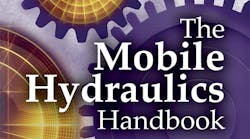Today’s mobile hydraulic machines have some of the most complex hydraulic systems around. This is particularly true when it comes to many of the controls devised for variable displacement pumps and motors. Semi cross-sensing, power summation, open- and closed-center load sensing, positive and negative displacement control, constant torque and constant speed control for closed circuits, just to name a few. Even a directional control valve is not just a directional control valve on a mobile machine. It can incorporate power beyond, anti-saturation, work port pressure limitation, load signal amplification, pre- and post-compensation, anti-cavitation, differential pressure limitation, and much more.
This apparent complexity explains why dedicated professionals who work on mobile hydraulic equipment often remark that they need a manual just to decode the machine’s manual. They do! And now a new book by popular hydraulics author Brendan Casey explains what mobile hydraulics practitioners need to understand in order to succeed.
“The Mobile Hydraulics Handbook is written especially for professionals who make their living, or a significant part of it, off the back of mobile hydraulic machines,” Casey says. “Each of the book’s 14 chapters begins with a review of the fundamentals, and from there moves quickly into the advanced aspects of mobile hydraulic control. And while proportional and electronic control are covered in detail, a big chunk of this new book is devoted to variable pump and motor controls, hydrostatic transmission controls and load-sensing systems. Because for the accomplished mobile hydraulics specialist who works at the coal-face solving problems, this is where the money is today.”
The Mobile Hydraulics Handbook has a sticker price of $129 and for H&P readers who take advantage of a limited, introductory offer it comes with a free ebook; Relay and PLC Logic for Hydraulic Technicians, a $30 value, plus free shipping to anywhere in the world.
For more information about the book or to order a copy, visit: www.HydraulicSupermarket.com/books. Or contact the author, Brendan Casey by email: [email protected] or telephone: +618 6102 5354

